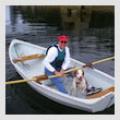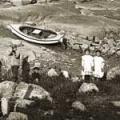Letters to the Editor - Issue 128
Issue 128
The things cormorants do
Cormorants. Ah, yes (MBH&H, Winter 2014). They are a constant summer presence. There’s been one of them visiting in mid-September, past couple of years, that uses the bow of my 16' 1960s Whaler as a first-class fish-spotting platform, and first-class outhouse. Daily deposits.
So bird-lover though I am, I decided that this year it was time to purchase one of those fearsome, lifesize, plastic great-horned owls with realistic glass eyeballs to scare off the outhouser. I set it up, right there in the bow. Fearsome.
Next morning, right next to the owl, yeah, another white, mushy deposit. I moved the beast around daily, as per instructions, to make it seem more alive. Next day, another deposit. I moved the critter onto the dock, right next to the boat. Next morning, I saw two cormorants sit side by side and dump.
Perhaps it’s divine retribution for my own occasionally anal behavior?

CREDIT: Photograph by Peter Ralston
Two-holer with a view
Inspired by the confluence of downloading a summer’s worth of pictures from my iPhone and the appearance of Eva Murray’s fine piece titled “A Room With a View” (MBH&H, Winter 2014), I thought to share this photograph of my favorite two-holer on this coast. From it, one can sit and (almost) behold the island of Matinicus on the southern horizon.
Herb Parsons
Vinalhaven/North Haven, Maine

CREDIT: Photograph by Peter Ralston
Peter Ralston
Rockport, Maine
A fine vignette
I picked up a year-old edition (MBH&H, Winter 2013) on a waiting room table and had a chance to read just a couple of things, but the “Capturing the Magic” piece by Publisher John K. Hanson, Jr. made my day. We just put away our trawler (formerly 30 years on sailboats and a circumnavigator) for the season, and miss her already. This short vignette shows his understanding of sailing, demonstrates humility, and tells me that he gets it right more than not. Good on ya, John Hanson.
Charles Osgood
Bangor, Maine
New Yorker-worthy writing
The Bill Mayher column “A Letter from Home” (MBH&H, Winter 2014) was in my opinion New Yorker magazine quality writing. The story was so poignant and real. I was in Maine often in the early seventies. It was like another country, with another currency. No one had any “folding money.” I used to stay with people who had a dirt floor and no running water. Several of my close friends from Boston went to live on and from the land when they graduated from college in 1973. Their ideas and attitudes were well recounted by Mr. Mayher. I chose to come back home to New York City to begin a commercial life. I have often wondered what it would have been like to have gone to Maine then.
Recent trips and a long association with Rockport, Maine, have given us the window on the new generation of craftsmen and farmers and the vibrancy they bring to the state. Thanks for the great article and the great insights.
Jonathan Russo
New York, New York
Rising tide rebuttal
Catherine Schmitt takes on a difficult topic and does a good job of explaining many aspects of it (“Rising Tide” MBH&H, Winter 2014, Issue #127). However, she makes a few errors along the way. The first is “During this time, 12,500 years ago, which geologists call the marine ‘highstand’, sea levels were about 250 feet higher than they are today.” This is not true. Sea level during the Current Interglacial Warm Period was never more than a few feet different from today. The last time sea level was significantly higher was during the previous Interglacial Warm Period 120,000 years ago, and that level was only 20 feet above today’s. There is not enough ice in the world to melt and cause a 250-foot rise in sea level.
The second error is “Freed from the weight of the ice, the land rebounded, and pushed the sea level 164 feet below where it is today.” Sea level did not change during this period. The land did rise relative to sea level when glaciers were removed. It did not sink again by a similar amount as implied by her statement.
The graphic illustration is in error as presented. Perhaps with relabeling it could be explained in a way that made sense, but the two notations and accompanying legend are incorrect.
My home has a floor elevation of 14 feet, and our local spring tide is about 9 feet, so I take this subject seriously.
Nick Fast
Hilton Head Island, South Carolina
Catherine Schmitt replies:
The subject of sea level is complex, and the relative sea level changes noted in Maine are quite different from those experienced well south. My scientific sources have confirmed that the graphic in the article is correct, and clarified the description of post-glacial sea level changes in Maine: A layer of soft material beneath earth’s rigid crust allows the land surface to move in response to the advance and retreat of a large, heavy ice sheet. The ice pushed the Maine landscape down; when the ice melted, the rebound of the land surface was slow, allowing the sea to flood inland, submerging coastal areas with 250 feet of marine water. This last occurred 15,000 years ago. Rebound of the surface 12,000 years ago then caused a relative drop in sea level, placing the Maine shoreline at a position that is now 200 feet below current sea level. Then the sea again inundated Maine’s coast, as glacial meltwater continued to increase the volume of the ocean.
Maine’s post-glacial highstand and lowstand shorelines are well-established, based on geological and fossil evidence. Higher-than-present shorelines are marked by old river deltas, beaches, marine sediments, and well-dated marine fossils. Lowstand shorelines are also identified by terrestrial fossils, such as mastodon remains and freshwater peats recovered from areas now offshore.
Those who want to learn more might want want to check out Maine’s Ice Age Trail, http://iceagetrail.umaine.edu/
Researching Sam Rabl
I am trying to learn more about Sam Rabl. Most of what I find on the Internet is about his books and boats, but I did discover an article in your magazine (MBH&H #110, July 2010) by Peter Spectre, titled “From Whence We Came” that contained a few paragraphs about him. That article alone more than doubled the scant information I had so far.
Can any of your readers point me toward more information regarding the man?
David Morgan
Bremerton, Washington
Lighthouse research
In your Winter issue (MBH&H #127) Jan Conrad of Camden, Maine, answered my question about the white sides and red roofs on many lighthouses and U.S. Coast Guard Stations. I thank her very much for her research and reply.
Her answer comports well with that of a volunteer aboard the Light Ship Columbia docked at Astoria, Oregon. When I learned that the volunteer was USCG-retired I asked my question yet again. Where does the color tradition originate for red over white at Coast Guard stations?
He responded that the tradition at Coast Guard Stations likely came from the colors used for lighthouses and the Life-Saving Service Stations that preceded the USCG.
Roy Heberger
Still land-locked in Boise, Idaho
















